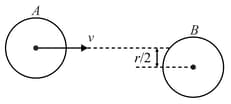The diagram shows the velocity as a function of the time for an object with mass being pushed along a frictionless surface by external force. At , the force stops pushing and the object moves freely. It then collides head on and sticks to another object of mass :-
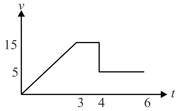


Important Questions on Centre of Mass, Momentum and Collisions
A particle of mass is released from rest from a point of a wedge of mass free to slide on a frictionless horizontal plane. The particle slides down the smooth face of the wedge. When the velocity of the wedge is the velocity of the particle in relative to the wedge is:-
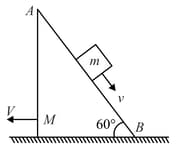
A ball of mass is suspended by an inextensible string long attached to a point of a smooth horizontal bas resting on a fixed smooth supports and . The ball is released from rest from the position when the string makes an angle of with the vertical. The mass of the bar is . The displacement in meters of the bar when the string makes the maximum angle on the other side of the vertical is:-

Find the distance between centre of gravity and centre of mass of a two particle system attached to the ends of a light rod. Each particle has same mass. Length of the rod is , where is the radius of earth:-
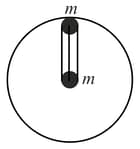
Three blocks and each of mass are placed on a surface as shown in the digram. Blocks and are initially at rest. Block is moving to the right with speed . It collides with block and sticks to it. The combination collides elastically with block . Which of the following statement is (are) true about the velocity, of block and .

Two masses and of mass and respectively are connected by a compressed ideal spring. The system is placed on a horizontal frictionless table and given a velocity in the -direction as shown in the digram. The spring is then released. In the subsequent motion the line from to always points along the unit vector. At some instant of time mass has a -component of velocity as . The velocity of mass at that instant is:-
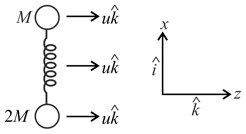
A disk of radius moving on perfectly smooth surface at a speed undergoes an elastic collision with an identical stationary disk . Find the velocity of the disk after collision if the impact parameter is as shown in the figure:-
